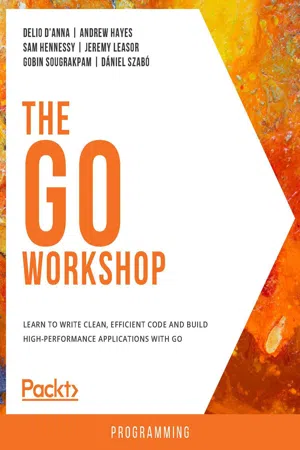
The Go Workshop
A New, Interactive Approach to Learning Go
Delio D'Anna, Andrew Hayes, Sam Hennessy, Jeremy Leasor, Gobin Sougrakpam, Dániel Szabó
- 822 Seiten
- English
- ePUB (handyfreundlich)
- Über iOS und Android verfügbar
The Go Workshop
A New, Interactive Approach to Learning Go
Delio D'Anna, Andrew Hayes, Sam Hennessy, Jeremy Leasor, Gobin Sougrakpam, Dániel Szabó
Über dieses Buch
Get started with Go and learn how to leverage its simplicity and flexibility to solve real-world problems and build practical software
Key Features
- Build a comprehensive foundation in Go and focus on developing real-world applications
- Explore the Go Standard Library and learn how to structure your code
- Learn how to efficiently interact with files, databases and REST APIs
Book Description
The Go Workshop will take the pain out of learning the Go programming language (also known as Golang). It is designed to teach you to be productive in building real-world software. Presented in an engaging, hands-on way, this book focuses on the features of Go that are used by professionals in their everyday work.
Each concept is broken down, clearly explained, and followed up with activities to test your knowledge and build your practical skills.
Your first steps will involve mastering Go syntax, working with variables and operators, and using core and complex types to hold data. Moving ahead, you will build your understanding of programming logic and implement Go algorithms to construct useful functions.
As you progress, you'll discover how to handle errors, debug code to troubleshoot your applications, and implement polymorphism using interfaces. The later chapters will then teach you how to manage files, connect to a database, work with HTTP servers and REST APIs, and make use of concurrent programming.
Throughout this Workshop, you'll work on a series of mini projects, including a shopping cart, a loan calculator, a working hours tracker, a web page counter, a code checker, and a user authentication system.
By the end of this book, you'll have the knowledge and confidence to tackle your own ambitious projects with Go.
What you will learn
- Understand Go syntax and use it to handle data and write functions
- Debug your Go code to troubleshoot development problems
- Safely handle errors and recover from panics
- Implement polymorphism by using interfaces
- Work with files and connect to external databases
- Create a HTTP client and server and work with a RESTful web API
- Use concurrency to design software that can multitask
- Use Go Tools to simplify development and improve your code
Who this book is for
The Go Workshop is designed for anyone who is new to Go. Whether you're beginning your journey as an aspiring developer, or are experienced with another programming language and want to branch out to something new, this book will get you on the right track. No prior programming experience is necessary.